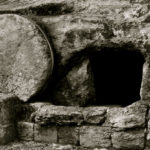What are we to make of Jesus’ absence at the end of Mark’s Gospel? The women find the tomb empty and a young man tells them of the resurrection. The youth then instructs them to tell the disciples that Jesus is going ahead to meet them in Galilee. But the women flee from the tomb… and say “nothing to anyone, for they were afraid.”
That’s it. The end. No Jesus.
The earliest manuscripts we possess do not contain anything after 16:8. 16:9-20 appears to be one attempt to erase the uneasy feeling the ending at 16:8 leaves.
Why would the author leave his audience anticipating an appearance of the resurrected Jesus that, as far as the narrative is concerned, never comes? The simple and surprising answer is that it detracts from his message. By not recording a resurrection appearance, Mark has placed more weight on other apparently more important details.
What could be more important?
Before I answer that, I need to point out Mark’s special enigmatic quality. Its typical of Mark not to explain his meaning but to leave a trail of bread-crumbs for his readers to follow. Mark shows. He doesn’t typically tell. Here’s an example: Mark never identifies John the Baptist as Elijah. What Mark does is describe John as dressed in a leather belt (Mark 1:6), which if you know the OT will point you to Elijah (2 Kings 1:8). Mark also presents John’s death through the machinations of a royal couple who, if you know the OT, will seem surprisingly reminiscent of Elijah’s enemies, Ahab and Jezebel (Mark 6, 1 Kings). Mark even quotes from Malachi and alludes to the promise of Elijah’s coming at the end of that book (Mark 1:3, Mark 9:9-13). But not once does Mark explicitly say that John the Baptist was Elijah or an Elijah figure. That explicit connection is found only in the other gospels. Matthew, for instance, adapting Mark, makes this identification plain (Matthew 11:14). Mark, however, is obscure. He leaves his readers to follow clues to arrive at this conclusion. From this example and other like it, its clear that Mark expected a great deal of knowledge and sensitivity on the part of his readers.
Surprisingly, Mark spends most of his short ending returning to the stone at the entrance of the tomb – three times in fact. In 15:46, Mark informs reader that Jesus’ tomb “had been cut out of the rock” and it was sealed by rolling a stone against the entrance. And when the women arrive in 16:3, three verses later, they wonder, “who will roll away the stone?” The answer comes in the following verse when they discover the “stone had been rolled back.” Mark further adds “that it was very large.” Why such stress on this detail? Remember Mark chooses to focus on this detail rather than a meeting with the resurrected Jesus. Why?
Interestingly, the only other place in Mark we read about stones is in the section dealing with Jesus’ judgment of Jerusalem and the temple (Mark 11-13). There we find two scenes referring to stones. The first occurs at the end of Jesus’ parable of the tenants and deals with the reversal of fortune for the rejected stone (jesus and or the “others”) in the coming destruction of the temple. The next appears less than a chapter later at the introduction of the Olivet Discourse. The disciples admiration for the stones of the temple, prompts Jesus to remark that they will all be thrown down. Again the readers are pointed to a reversal of fortune for stones brought about by the coming destruction of the temple. For these two references, at least, stones are clearly connected with Jerusalem’s destruction.
Is it possible then that the rolled stone from the tomb’s entrance points to the same meaning? In the Olivet Discourse (Mark 13), Jesus explicitly connects the coming destruction of Jerusalem and the temple with the coming of the Son of Man, which is a clear reference to Daniel 7. In Daniel, that event brings about an end to the four beastly kingdoms and the establishment of a kingdom without end, represented in the coming of the Son of Man. But readers familiar with Daniel should in this reference also recall Daniel 2 and its related prediction. There, we find an idol/image with four different metals, also representing four kingdoms, which are likewise destroyed and supplanted by an everlasting kingdom. But instead of the Son of Man, however, the image in Daniel 2 is destroyed by a stone cut out from the mountain without human hands.
Daniel 2’s description of the stone matches in several ways Mark’s depiction of the tomb and its entrance. Daniel says it was a stone cut out from a mountain (Daniel 2:34, 45) while Mark tells his reader the apparently otherwise-needless detail that the tomb had been cut out of the rock (Mark 15:46). Daniel also points to the divine origin of the stone which was “cut out by no human hands” just as Mark seems to point to some invisible hand which has rolled the “large” stone. All this appears to suggest that the destruction of the temple and the establishment of the eternal kingdom have begun in the resurrection of Jesus. The rolling of the stone is the first movement of the kingdom that has no end.
















